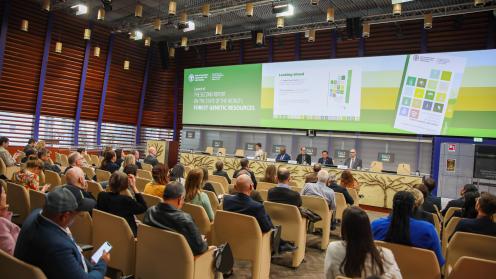- Courses
- GS Full Course 1 Year
- GS Full Course 2 Year
- GS Full Course 3 Year
- GS Full Course Till Selection
- Online Program
- GS Recorded Course
- NCERT (Recorded 500+ Hours)
- Polity Recorded Course
- Geography Recorded Course
- Economy Recorded Course
- AMAC Recorded Course
- Modern India, Post Independence & World History
- Environment Recoded Course
- Governance Recoded Course
- Science & Tech. Recoded Course
- International Relations and Internal Security Recorded Course
- Disaster Management Module Course
- Ethics Recoded Course
- Essay Recoded Course
- Current Affairs Recoded Course
- CSAT
- 5 LAYERED ARJUNA Mentorship
- Public Administration Optional
- ABOUT US
- OUR TOPPERS
- TEST SERIES
- FREE STUDY MATERIAL
- VIDEOS
- CONTACT US
CGRFA-20: Global Action on Genetic Resources for Food and Forests
CGRFA-20: Global Action on Genetic Resources for Food and Forests

Context
The 20th session of the Commission on Genetic Resources for Food and Agriculture (CGRFA-20) was held in Rome from March 24 to 28, 2025, with participation from 179 countries and the European Union. Organised by the FAO, the session focused on biodiversity conservation, launching two key reports on plant and forest genetic resources.
About the CGRFA-20 Meeting
- The 20th session of the Commission on Genetic Resources for Food and Agriculture (CGRFA-20) is being held in Rome from March 24, 2025.
- It is organised by the Food and Agriculture Organization (FAO) of the United Nations, which works to improve food systems and protect agricultural biodiversity.
- CGRFA is the only permanent global forum dedicated to the conservation and sustainable use of biodiversity for food and agriculture.
- The session also addressed emerging challenges such as digital sequence information (DSI), the role of biotechnologies, and mechanisms for fair and equitable benefit sharing from genetic resources.
- The meeting brings together governments, researchers, and global experts to address how genetic diversity supports climate adaptation, food security, and sustainable agriculture.
Launch of Two Major FAO Reports
- Two key FAO reports are being launched during CGRFA-20:
- The Third Report on Plant Genetic Resources (March 24).
- The Second Report on Forest Genetic Resources (March 26).
- These reports build on earlier global assessments and provide updated data on biodiversity conservation, threats, and policy progress.
- They also introduce new data systems and propose strategies to integrate genetic diversity into national and global agendas for food and forest systems.
Key Highlights – Plant Genetic Resources Report
- The Third Report on the State of the World's Plant Genetic Resources for Food and Agriculture, based on data from 128 countries and several research centres, presents a global review of crop biodiversity and conservation efforts.
- The report stresses that 80% of the food we consume is plant-based, highlighting the central role of plant diversity in global food security.
- Over 6 million plant samples are conserved across 867+ genebanks at national, regional, and international levels.
- Safety duplication of samples rose from 15% in 2014 to 41% by 2022, boosting resilience.
- Example of safety duplication is the Svalbard Global Seed Vault in Norway — often called the “Doomsday Vault” — where gene banks from around the world deposit backup copies of their seeds for long-term security.
- The reports warns that over 40% of plant species surveyed have disappeared from their original natural or cultivated habitats.
- Challenges include limited sample regeneration, weak data infrastructure, and inadequate funding for gene-banks.
- The report highlights the role of Indigenous Peoples, small farmers, and local communities as key biodiversity stewards.
- Despite advances in biology and informatics, many countries still under use modern tools in genetic conservation.
- The global seed market has grown from $36 billion in 2007 to over $50 billion in 2020, with 40 countries improving their seed systems.
- Initiatives like the Crop Wild Relatives (CWR) Project have helped conserve over 500,000 samples of wild crop varieties.
- Platforms like Genesys, a global database of conserved crop diversity, support information sharing and access.
- The report calls for urgent action against climate threats, land degradation, and conflict-driven biodiversity loss.
- It builds on findings from 1996 and 2010, noting progress but also persistent conservation gaps.
- The report emphasizes the importance of preserving genetic diversity not just for food security, but also for maintaining traditional practices and cultures worldwide
Key Highlights – Forest Genetic Resources Report
- The report draws data from 77 countries, representing over 75% of global forest cover.
- Nearly two-thirds of countries now maintain national inventories of forest genetic resources, with data contributions from governments, researchers, and local communities.
- It identifies 58,000 tree species, 1,600 woody bamboo species, and 500 rattan species — with nearly 30% of tree species threatened, especially in tropical regions.
- Conservation efforts include:
- 2,800 species of trees and woody plants documented.
- 1,800 genetically characterized.
- 1,400 in in situ conservation (natural habitats).
- 1,100 in ex situ programs (e.g., seed banks).
- Key threats include deforestation, degradation, climate change, pests, fires, and invasive species.
- While common species retain genetic variety, rare and threatened trees show major genetic loss.
- Many countries face shortages of seeds and planting materials, affecting reforestation efforts.
- Over two-thirds of countries now run national tree-seed programs, though awareness and uptake remain low globally.
- Scientific progress has improved taxonomy and risk assessments, but most species remain under-studied.
- The report urges stronger action under the Global Plan of Action, better climate-linked conservation, and innovation in forest products.
- It introduces a new global monitoring platform and recommends mainstreaming forest genetics into climate and biodiversity strategies.
- The 2025 report builds on the 2014 edition, measuring progress while identifying policy and implementation gaps.
- The report also aims to raise global awareness about the critical role of forest genetic resources — not just for ecosystems, but for long-term food, climate, and human security
Global Importance and Future Agenda
- CGRFA-20 emphasizes that genetic resources are the backbone of climate-smart food and forest systems.
- Climate-Smart Agriculture (CSA) is promoted as a core strategy to increase productivity, build resilience, and lower emissions.
- The World Bank has raised CSA investment to $3 billion annually, with all new projects aligned to the Paris Agreement since 2023.
- Efforts like the CGIAR Genebanks Accelerator are expanding access to over 3,500 plant species for researchers and farmers worldwide.
- A whole-of-government approach is recommended to align policies on agriculture, climate, and biodiversity.
- Local initiatives, often led by Indigenous communities and grassroots networks, are seen as essential for long-term transformation.
- With 77 countries participating, CGRFA-20 is driving momentum for stronger institutional collaboration between genebanks, policy bodies, and climate agencies.
India’s Efforts on Genetic Resources for Food and Forestry
1. Plant Genetic Resources
- India is home to over 811 cultivated crop species and 902 wild relatives, making it one of the world’s richest countries in plant biodiversity.
- The National Bureau of Plant Genetic Resources (NBPGR) under ICAR conserves more than 470,000 accessions at its National Gene Bank in New Delhi, established in 1996.
- A second National Gene Bank has been announced to store up to 1 million germplasm lines, enhancing long-term preservation capacity for both public and private sector use.
- India actively participates in global conservation efforts, contributing to platforms like Genesys and the Svalbard Global Seed Vault for safety duplication.
- Despite strong institutional frameworks, challenges remain in sample regeneration, data management, and sustainable funding for genebanks.
- National-level initiatives such as the Paramparagat Krishi Vikas Yojana, National Mission on Sustainable Agriculture, and ICAR’s AICRPs support conservation of traditional varieties and climate-resilient crops.
2. Forest Genetic Resources
- India is implementing major forest conservation policies, including the National Agroforestry Policy (2014), the Green India Mission, and the Forest Fire Prevention & Management Scheme (FFPM).
- The Green India Mission aims to expand forest and tree cover by 5 million hectares and improve the quality of another 5 million hectares, with a focus on native and climate-resilient species.
- The Indian Council of Forestry Research and Education (ICFRE) and State Forest Departments manage tree seed centers, promote in situ and ex situ conservation, and monitor forest biodiversity.
- India has developed over 275,000 People’s Biodiversity Registers (PBRs), documenting local ecosystems and traditional knowledge, including species of genetic importance.
- The country faces challenges such as habitat degradation, low public awareness, and gaps in forest genetic resource monitoring, especially for lesser-known species.
- India is a signatory to the Nagoya Protocol and implements the Biological Diversity Act (2002) through the National Biodiversity Authority (NBA), ensuring regulated access and benefit-sharing.
Conclusion
The CGRFA-20 meeting in Rome marks a turning point in the global commitment to safeguard biodiversity for food and forestry. The two landmark FAO reports do more than highlight past challenges — they lay out clear pathways for the future: smarter genetic conservation, community-led stewardship, and climate-adaptive innovation. The next decade will demand bold national actions, integrated global cooperation, and renewed investment in genetic resources. What is preserved today will shape how the world eats, farms, and survives tomorrow.
About the Food and Agriculture Organization (FAO)
- The Food and Agriculture Organization (FAO) is a specialized agency of the United Nations, established in 1945 and headquartered in Rome, Italy.
- FAO works with over 130 countries to help build sustainable food systems, improve food and nutrition security, and promote the responsible use of natural resources.
- Its core focus areas include:
- Ending hunger and improving access to safe, nutritious food.
- Supporting climate-resilient agriculture and forestry.
- Conserving genetic resources and biodiversity for food and farming.
- Providing policy advice, technical support, and international data platforms.
- FAO manages the Commission on Genetic Resources for Food and Agriculture (CGRFA), the only permanent global body that oversees biodiversity conservation across plants, animals, forests, aquatic life, and microorganisms used in agriculture.
- The organization publishes several flagship global reports that guide countries in policymaking and conservation strategies, including:
- The State of the World’s Plant Genetic Resources for Food and Agriculture (1996, 2010, 2025)
- The State of the World’s Forest Genetic Resources (2014, 2025)
- The State of the World’s Animal Genetic Resources (2007, 2015)
- The State of the World’s Aquatic Genetic Resources (2019)
- The State of the World’s Biodiversity for Food and Agriculture (2019)
- The State of the World’s Forests (SOFO) – Biennial
- The State of Food and Agriculture (SOFA) – Annual
- The State of Food Security and Nutrition in the World (SOFI) – Annual
- These publications help monitor global progress, identify conservation gaps, and support evidence-based actions to protect the genetic foundations of food and forest systems.
|
Also Read |
|
UPSC Foundation Course |
|
| UPSC Monthly Magazine | CSAT Foundation Course |



